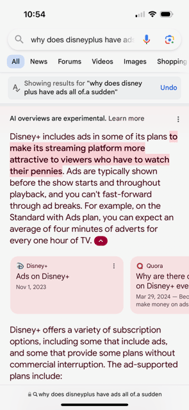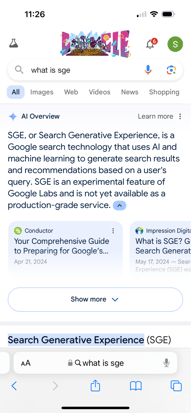-
 Written by Sean Dougherty
Written by Sean DoughertySenior Brand Creative at Funnel, Sean has more than 15 years of experience working in branding and advertising (both agency and client side). He's also a professional voice actor.
Google recently launched its newest take on search: AI-powered overviews. For Google’s users, its most evident effect is a generative AI “answer” appearing on top of all search results.
While it might sound cool and innovative, marketers in the know hate it. Why? Well, this new feature could mark a total paradigm shift in how websites attract and monetize audiences. Let us explain.
What are AI-powered overviews?
According to Google, AI-powered overviews are an approach to search that applies multimodal (more than one medium) large language models to results. This means users will see an AI-generated answer to their search query at the top of the results page.


Two examples of AI overviews on mobile
This new approach promises to allow Google to answer any user’s question more quickly, with more context and with greater complexity. In essence, this transforms Google from a pathway through which you can find answers into an automated chatbot force-feeding you answers.
Ask, and ye shall receive.
The backstory to the beef AI search
It’s no secret that Google commands a global stranglehold on search. This also means they maintain dominant power over where that searching traffic goes.
For years, marketers have been trying to keep pace with the search engine’s algorithm updates in order to reach the top positions of results pages. As our SEO expert, Thomas Frenkiel, can attest, there’s not much point to a web page if you aren’t ranking.
“It used to be that you needed to get on the first page in the search results to see traffic coming in,” said Thomas. “But in the last few years, you really need have to get a top three-position to see any results. This is mainly due to the increase in advertisements and featured snippets at the top of the results.”
The work to achieve these rankings covers a wide variety of strategies, from publishing expert-level knowledge in blog articles and working keywords into the entirety of your site to following best practices in your website builds. And as the industry collectively got better at achieving peak popularity via the algorithm, Google would make tweaks that prioritized different strategies — all in an effort to combat SEO spamming and improve the relevance of results for users.
At the same time, the economy of the internet has evolved to reward those websites that could capture the most traffic. Whether you’re a publisher relying on an ad model, an e-commerce company, a startup or a mom-and-pop digital brand, your revenues tend to closely correlate to your website’s traffic.
Which brings us to the problem…
AI overviews upend an industry
By putting a generative AI answer to a user’s query at the top of the page, it disincentivizes users to click on any actual web pages that appear in the SERP.
Why would a user go any further than the answer posted right in front of them? Sure, some people may want to investigate deeper, but most people may take the AI answer at face value.

If you, then, extrapolate this idea outward, you can imagine a world in which users don’t really need to visit websites and blogs that utilize thought leadership as a differentiator. After all, the AI has already scraped your website and used the expertise within to formulate its answer. In fact, users may not need to visit websites at all – meaning organic traffic will crater.
It’s this dynamic that has marketers up in arms. Their years-long battle to hit the top of the SERP seems to have been for naught. Though, this may only be digital doomsday in theory.
It’s generative AI — so it’s totally unreliable
As anyone who has used generative AI (this writer included) can attest, the current state of these tools is totally unreliable. Colloquially termed “hallucinations,” generative AI tools tend to make up facts and present them as universal certainties.
Why this happens is still a bit of a mystery, though it probably results from how the systems have been designed to mimic some forms of creativity and deliver information in a more “human” manner.
Google’s AI-powered overviews is (for better or worse) not immune to these hallucinations. A recent search for valid discount codes for internet-florist Bouqs turned up the usual sites for online coupons. However, it also featured the AI answer at the top of the page. The only problem? Every single one of the AI discount codes was outdated or totally made up.
Now, the SGE results do offer some links to the source material from which the AI derived its answer. However, what happens when it crawls outdated information or even two websites with opposing views?
What’s particularly strange is that users can easily see how inaccurate the AI answers can be, since the generative results sit in prime position followed by the actual human-vetted information. Within a matter of clicks, users are likely to develop a certain level of distrust with these results, no matter how certain and compelling they may seem.
Google as a cannibal?
Let’s put trustworthiness and accuracy aside for a moment. Perhaps the most confusing element of the SGE story is what this could do to Google’s cash cow: Google Ads.
As Google admits, the company makes most of its money from selling ad space next to search results. If SGE continues to improve, as one would expect a technology product to do, it will continue to discourage search users from scrolling down through the SERP and clicking on links to third-party sites. That could mean fewer clicks for their search ads, thereby cannibalizing their main revenue stream.
Now, Google is packed to the gills with smart strategists and managers. They are surely anticipating this risk and must have a business plan in their bakfickan (Swedish for back pocket) to make up revenue in other areas – for instance, renting compute power for other businesses to run AI models. And for what it’s worth, Google is claiming that they are still witnessing users clicking on source links – though, they have not yet provided hard evidence.
This odd dynamic has only added to marketers' confusion since much of the industry relies on Google ads for bottom-funnel, conversion-focused ads.
A mountain or a molehill?
There is no getting around it: SGE (even in its current form) will have a big impact on organic traffic volumes for websites around the world. That means marketers will need to rethink their approach to SEO, Google Ad spending and even the purpose of their websites.
Perhaps we are moving toward a future in which websites (outside of those enabled for e-commerce) simply become digital brochures. Perhaps the industry will shift budget away from conversion-based methods like Google Ads toward upper-funnel tactics that generate more brand awareness and customer demand.
Or, perhaps this is much ado about nothing. The quality of results is still quite suspect, and it's uncertain how quickly or by how much the technology will improve. That may mean SGE will become the sponsored links at the top of the SERP, something that users learn to ignore and scroll past.
The answer likely lies somewhere in the middle. Marketers need to start planning and adapting to a new paradigm in which their digital business model is inverted, while hoping that this is simply another technology dud. A sort of digital version of the flying car — long promised but never truly delivered.
-
 Written by Sean Dougherty
Written by Sean DoughertySenior Brand Creative at Funnel, Sean has more than 15 years of experience working in branding and advertising (both agency and client side). He's also a professional voice actor.
